Oradour-sur-Glane
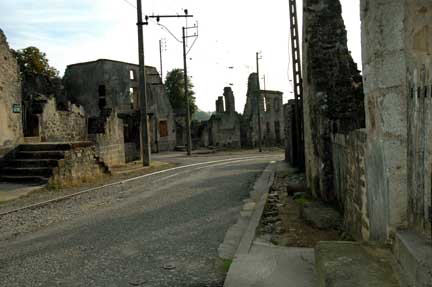
Notes from my trip to see the ruins
of the village, continued...
I am very glad that I visited Oradour-sur-Glane.
It was not at all what I had envisioned.
I had arrived in Oradour-sur-Glane in
time to check into my hotel and get to the Center of Memory by
4 p.m. on Saturday, so I immediately went to see the village
ruins. The weather was cloudy and overcast; it looked like rain
so I took along my umbrella. There was a bit of gentle rain,
like teardrops falling from the sky. In the late afternoon on
a gray day, the ruins had the look of a haunted place where the
ghosts of the dead still walk.
My first sight of the ruined village
was accompanied by a feeling of deep sadness. I grew up in Missouri
in a town the same size, so I could relate to the people that
once lived in Oradour-sur-Glane. My home town was very similar
to Oradour-sur-Glane with only one major street, plus a Fairgrounds,
a Catholic church, several schools where the children from the
surrounding farms were enrolled, a cobbler's workshop across
from the church, a smithy and a garage on the main street, and
several cafes.
Every house in my home town had a sewing
machine and many houses, including mine, had a well, just like
Oradour-sur-Glane. My town had a well digger, a blacksmith and
a cobbler, the same as Oradur-sur-Glane. My grandmother used
Limoges china for our weekly Sunday dinners. Antique dealers
from St. Louis used to stop by and try to buy the cups right
out of our hands, which used to amaze me.
My home town was located beside a river,
and train tracks ran through the town, stopping at the depot
on the main street, just like Oradour-sur-Glane. Meeting the
train was a social event in my town, just like in Oradour-sur-Glane.
The doctor was the most important man in town and his family
had been there for generations, just like the Desourteaux family
in Oradour-sur-Glane. We were isolated, far from the fighting
during World War II, and the war never touched our town, just
as the residents of Oradour-sur-Glane had nothing to do with
the war going on around them.
So I know what it was like to live in
such a village in 1944. Everyone not only knew your name, but
the names of all your ancestors, back several generations. There
were no address numbers on the houses because everyone picked
up his mail at the post office and everyone knew where everyone
else lived, and who had lived in the house 50 years ago. When
there was a wedding or a funeral, the whole town turned out,
and no invitations were necessary. If you ever needed help, you
didn't even have to ask. No one carried a set of keys: the houses
were left unlocked and the cars were parked with the keys left
in the ignition. The church was a sanctuary which was always
open. There was no police force because there was no crime.
I could easily imagine what it must have
been like on that terrible June day in 1944 when the SS soldiers
invaded this peaceful village, and I can understand the use of
the term "martyred village." It wasn't just the residents
that were murdered - the village itself was murdered. A whole
way of life was snuffed out in one afternoon.
The photo below shows a window with an
iron S-shaped hook that was used to hold back a shutter when
it was open. I was amazed to see this because my house had one
just like it.

The next day, on Sunday morning, I looked
out my window and saw that the town square was enveloped in fog.
I had breakfast at the hotel at 8 o'clock and then went to the
Center of Memory. While I was waiting for it to open, I took
the photo below, which is the view across the road from the Center
of Memory. In the background you can see the Upper Town with
the shell of the Desourteaux family home, and a low wall which
encircles the ruins. From the road, it is hard to tell that the
buildings are nothing but gutted shells, especially in the fog.
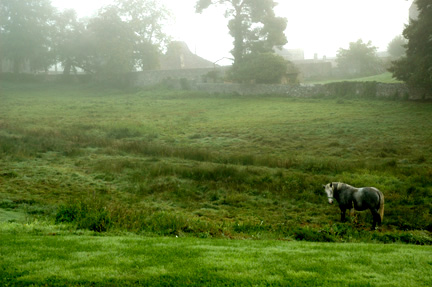
I took advantage of the fog that day
to take many of the photos on this web site, including the photo
below which shows the Beaulieu garage and smithy at the entrance
to the Fairgrounds. The village has been frozen in time, left
just as it was found the next day after the massacre. I was all
alone in the ruins in the early morning, and I could imagine
what it must have been like when the horror was first discovered
by villagers who had been gone for the day.
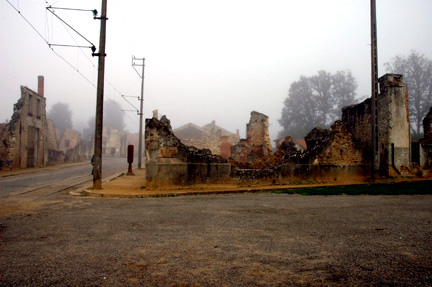
In the photo above, you can see a gas
pump located right at the curb on the main street, which is on
the left. My home town had a similar gas pump on the main street
where cars could just park and fill up the gas tank. The street
in the foreground is the entrance to the Fairgrounds which was
the market place for the town.
There were crowds of visitors going through
the ruined village on Sunday afternoon and even the next day,
on the first Monday in October. Most of the visitors were French-speaking
people over 50 who were on a bus tour, although there were a
few school groups also. I noticed that most of the women were
wearing dress shoes with high heels, not exactly appropriate
for a walk through the village which involves climbing a hill
and walking on a rough road. Before I went on my trip, I had
purchased a copy of "France for Dummies," which cautioned
Americans not to wear sneakers which are not elegant enough for
France. I ignored that advice and wore comfortable shoes.
I did not see anyone that I could identify
as American, but I did meet three people from the UK. One of
them was an 83-year-old woman who was a survivor of the bombing
of the English town of Coventry. She mentioned that Coventry
was bombed by the Germans because of the factories located there;
this was the first time I had ever heard that there was any justification
for the bombing of Coventry.
On my taxi ride from the airport, we
had passed several hamlets near the road which had stone buildings
made of gold colored granite. I realized that I was seeing what
the buildings in Oradour looked like before they were destroyed
by fire and explosives on June 10, 1944. All the photos that
I had seen of the ruins showed the buildings as gray and depressing,
blackened by smoke. The reality is that time has softened the
appearance of the ruins and the smoke stains have been washed
away by 60 years of rain. It is easy to see that this was once
a beautiful village even though not much is left of it now.
Comparing photos of the ruins that were
taken in 1944 with how the village looks today, I could see that
the buildings have deteriorated considerably. I did not see many
of the artifacts that had been photographed by others in previous
years. It was my impression that the ruins have changed dramatically
over the years.
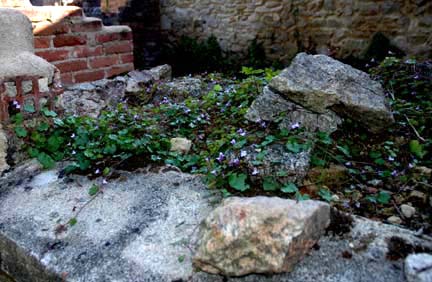
One thing that I noticed in the ruined
village is that the air is very fresh and clean, and there are
birds singing in the many trees that are still standing. I don't
know if an effort has been made to make the ruins look beautiful,
but there are attractive plants growing among the stones and
on the walls, as shown in the photo above.
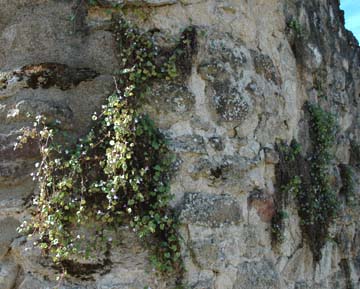
The photo above shows plants growing
on the wall of one of the ruined buildings. What looks like smoke
damage on some of the buildings is actually lichen and moss growing
on the walls.
The ruins of the old Oradour-sur-Glane
village are enclosed by a low stone wall which looks like it
has always been there, although I am sure that it was built after
the ruins were designated as a historical site. There is no entry
into the village before 9 a.m. so in the summer time there would
not be much time to make use of the early morning sun for photos.
I had studied maps of the ruined village before my trip, but
none of the maps were oriented toward the north, so I could only
guess which direction the church faced and where the sun would
be on the village green at any given hour.
I spent Saturday afternoon, Sunday and
Monday visiting the ruins and the new town. I really got a feel
for the village and what it must have been like. On the day that
I visited the cemetery, it was very hot, just like the weather
on the day of the massacre. The cemetery was a very sad place
and at first I could not bring myself to take photos there. The
martyrs of Oradour-sur-Glane included 207 children, many of them
from the hamlets surrounding the village. I returned later in
the day and took a few photos, including the grave of four little
girls, all from the same family, which was the saddest sight
of all.
I noticed that the cemetery is adjacent
to a road and there is a private gate which only those who know
the code for opening the lock can enter. This is the entrance
for the families of the victims who do not have to go through
the ruins to visit the graves. The survivors still return periodically
to visit the scene of their childhood, according to Sarah Farmers'
book, "Martyred Village."
I feel that the underground crypt, near
the cemetery, is not the right place for a museum. It is too
large for the small number of relics, too dark and too creepy.
Originally, the building was meant to be a tomb for the remains
of the victims, but the survivors of Oradour-sur-Glane rejected
it and built a new monument to hold the ashes. The displays in
the crypt should be moved to the Center of Memory in my humble
opinion.
|